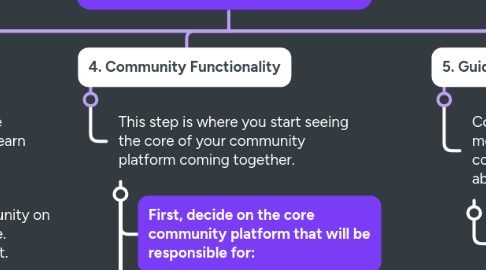
1. 1. Big Purpose + UVP
1.1. Your big purpose is the motivation for your ideal members to show up and pay for your community
1.1.1. Define your purpose focusing on three things:
1.1.1.1. 1.Transition: The period of people changing from one state to another
1.1.1.2. 2. Results: Things that someone in your transition wants
1.1.1.3. 3. Bridge: Activities members do to move from your transition to the result
1.1.1.4. Formula to craft your purpose:
1.2. Differentiate yourself from your competitors with a UVP
1.2.1. To come up with a unique value proposition (UVP) :
1.2.1.1. 1. Identify your strengths
1.2.1.2. 2. Conduct extensive competitor research
1.2.1.3. 3. Provide your ideal member's wants and needs
2. 2. Brand + Vision
2.1. Build a brand to develop your community into something bigger than just your name
2.1.1. Become recognized outside of your audience
2.1.2. It gives your community an identity
2.2. Create a vision for your members to gather around
2.2.1. A great way to do this is to craft a community manifesto outlining your communities:
2.2.1.1. 1. Values
2.2.1.2. 2. Principals
2.2.1.3. 3. Ethics
2.2.2. This further bonds your community as a collective rather than just a group of individuals
3. 3. Digital Presence
3.1. You need a place where people can find your community and learn more about it.
3.1.1. Avoid hosting your community on your own personal website. Promote it but don't host it.
3.1.2. Remember, we want to make it its own distinctive brand.
3.1.3. The main two digital outlets you need is a:
3.1.3.1. 1. Website/landing page
3.1.3.2. 2. Social media
4. 4. Community Functionality
4.1. This step is where you start seeing the core of your community platform coming together.
4.1.1. First, decide on the core community platform that will be responsible for:
4.1.1.1. 1. Systemizing and platforming your content
4.1.1.2. 2. Onboarding process
4.1.1.3. 3. Backend + payments
4.1.2. There are a few community platforms to choose from, my recommendations are:
4.1.2.1. 1. Circle.so
4.1.2.2. 2. Might Networks (My favorite)
4.1.2.3. 3. Podia
4.1.2.4. 4. Memberful
4.1.3. Once you have decided on the platform for your content now it's time to decide on the platform for your engagement
4.1.4. For 95% of communities you will have one engagement platform to choose from:
4.1.4.1. 1. Discord
4.1.5. It has all the quirks and features you need for your community to engage with each other and with you.
4.1.6. Unless your community is very professional then chose Slack
4.1.7. The core elements when building out a community server consists of:
4.1.7.1. 1. Roles: For permissions and hierarchy
4.1.7.2. 2. Channels: Organizing conversations
4.1.7.3. 3. Events: Live calls, meetups, Q & A's, etc.
4.1.7.4. 4. Server apps: Gamify, automation, moderate
4.1.8. These may vary for each unique community
5. 5. Guidelines and Rules
5.1. Come up with rules and a moderation strategy to keep your community from trolls, spam, and abuse.
5.1.1. Such guidelines will typically cover the following:
5.1.1.1. 1. Member behavior: what is expected of members
5.1.1.2. 2. Moderator behavior: what moderators can and can't do
5.1.1.3. 3. Complaint + resolution process: How can members flag complaints, and how do you handle them
5.1.1.4. 4. Topical guidelines: what topics are in the scope of the community
6. 6. Launch Strategy
6.1. It's finally time to launch your community. However, do not start by launching to the public first.
6.1.1. There are typically three stages involved in the launch strategy:
6.1.1.1. 1. The Alpha Launch
6.1.1.1.1. Invite some of your closest audience members to come in early, explore and provide feedback.
6.1.1.2. 2. The Beta (founders) Launch
6.1.1.2.1. Here you launch your community to a curated group. Offer a discounted price for your founders and give them a special badge within your community.
6.1.1.3. 3. The Public Launch
6.1.1.3.1. Make your community available to the public and launch a wide announcement. You have pre-existing engagements, kirks have been ironed out, and you have confidence in your offer and testimonials.
7. 7. Promote, Iterate & Grow
7.1. After you launch , you should expect the inevitable dip. This is where you can figure out what worked and did not work.
7.1.1. The answer to the dip is "workshopping". A set of experiments you build after your Launch and you know what part of your initial plans did and did not work.
7.1.2. There are four main types of experiments you can run to boost engagement and see growth:
7.1.3. 1. Online courses
7.1.3.1. Structure content and activities into a beginning, a middle, and an end.
7.1.4. 2. Challenges
7.1.4.1. Organize discrete, specific actions that a Host of a community lays out for members to complete together
7.1.5. 3. Experiences
7.1.5.1. Includes anything from a live stream or weekly meetings to a trip or workshop.
7.1.6. 4. Collabs
7.1.6.1. These take place between your members and shows that your members have been able to find each other and build something special together.
7.1.7. Workshopping unlocks engagement. Engagement and growth practices lead to self-organization and a sustainable community.
